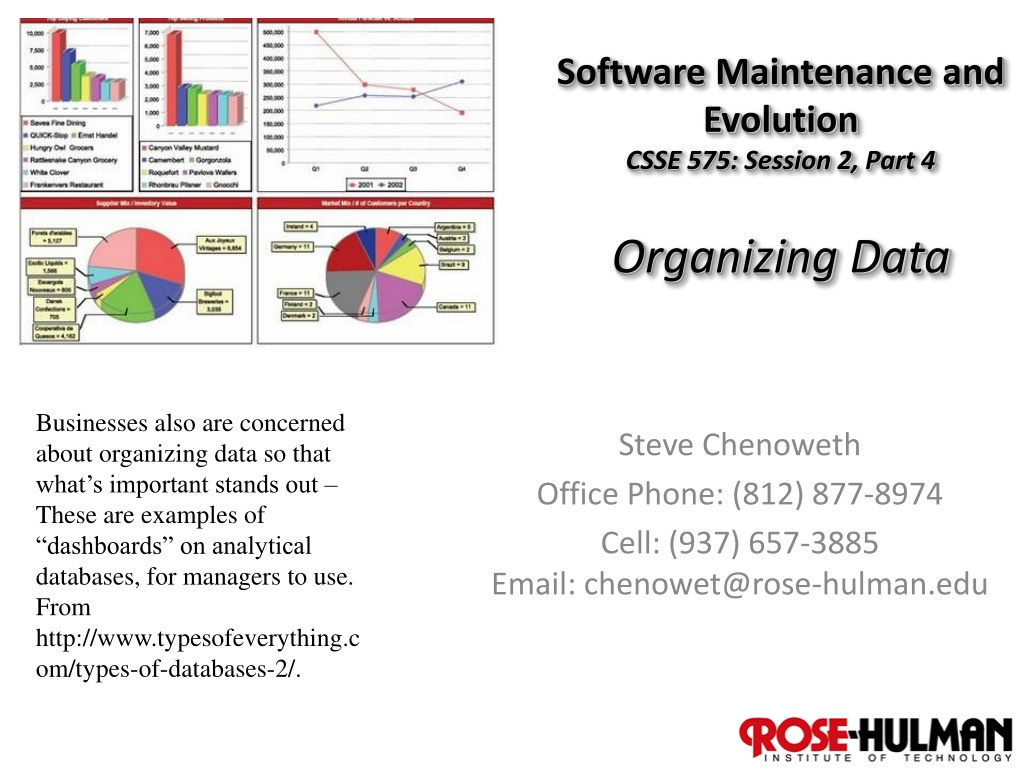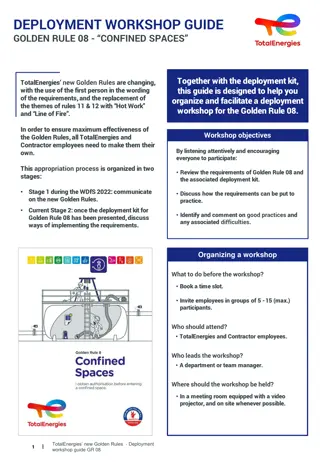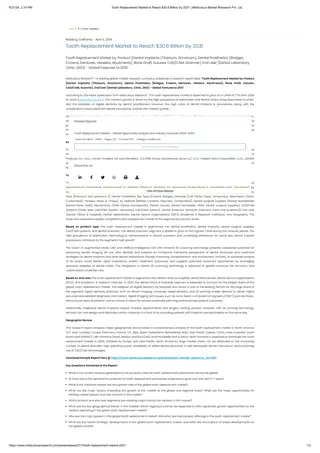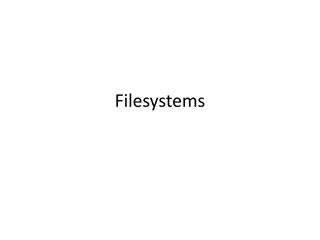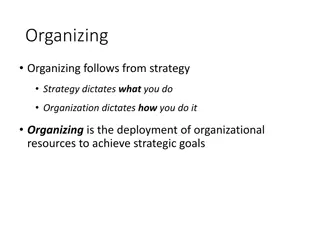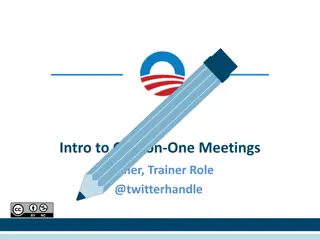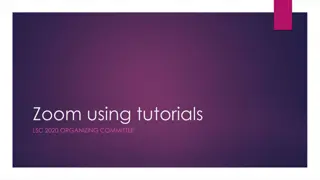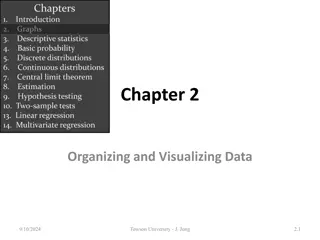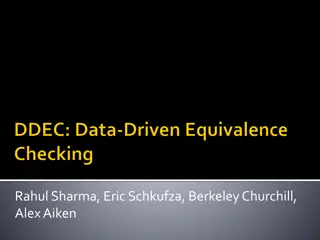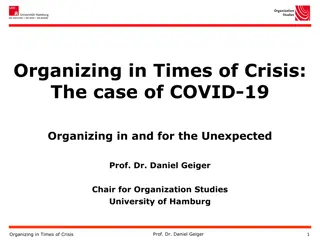Organizing Data Refactorings for Improved Data Management
Businesses are increasingly focused on organizing data effectively to highlight key information. Refactorings play a crucial role in making data manipulation easier and more efficient. This includes various techniques such as self-encapsulation, changing unidirectional associations to bidirectional, and replacing magic numbers with symbolic constants. Understanding and applying these refactorings can greatly enhance data management in analytical databases.
Download Presentation

Please find below an Image/Link to download the presentation.
The content on the website is provided AS IS for your information and personal use only. It may not be sold, licensed, or shared on other websites without obtaining consent from the author. Download presentation by click this link. If you encounter any issues during the download, it is possible that the publisher has removed the file from their server.
E N D
Presentation Transcript
Software Maintenance and Evolution CSSE 575: Session 2, Part 4 Organizing Data Businesses also are concerned about organizing data so that what s important stands out These are examples of dashboards on analytical databases, for managers to use. From http://www.typesofeverything.c om/types-of-databases-2/. Steve Chenoweth Office Phone: (812) 877-8974 Cell: (937) 657-3885 Email: chenowet@rose-hulman.edu 1
A Basic Rule of Refactoring Refactor the low hanging fruit http://c2.com/cgi/wiki?RefactorLowHangingFruit Low Hanging Fruit: The thing that gets you most value for the least investment 2
Some good questions About Do we refactor this, or not? Do we expect to change this code soon? Do people need to understand this code, to do something else right? Can other people understand the code? 3
Recall: Composing Methods Some Bad Code Smells Long method Duplicated code Comments to explain hard-to-understand code Representative Refactorings Extract Method Turn a code fragment into a method whose name explains the purpose of the method Introduce Explaining Variable Put the result of an expression in a temporary variable with a name that explains the purpose Remove Assignments to Parameters Use a temporary variable 4
Recall: Moving Features Between Objects Some Bad Code Smells Data class Class with only get / set methods, and nothing else Feature envy Method more interested in other classes methods than in it own class methods Large class Representative Refactorings Move Method/Field Move a method/field from one class to another Extract class Create a new class and move field & methods to the new class Inline class Move fields & methods to another class 5
Organizing Data Refactorings that make working with data easier Lots of them! We ll be selective Self Encapsulate Field Replace Data Value with Object Change Value to Reference Change Reference to Value Change Unidirectional Association to Bidirectional Replace Magic Number with Symbolic Constant Encapsulate Field Replace Array with Object Duplicate Observed Data Change Bidirectional Association to Unidirectional Encapsulate Collection Replace Record with Data Class Replace Type Code with Class Replace Type Code with Subclasses Replace Type Code with State/Strategy Replace Subclass with Fields 1. 10. 2. 11. 3. 12. 4. 13. 5. 14. 6. 15. We ll do these! 7. 16. 8. You read about these! 9. 6
Organizing Data Some Bad Code Smells Explaining comments Public fields Representative Refactorings Replace magic number with symbolic constant Area = 3.14159265 * r * r; // bad Static final int PI = 3.14159265; Area = PI * r * r; // better Encapsulate field Public fields are bad Use private field & get / set methods 7
Replace Magic Number with Symbolic Constant Motivation Magic numbers are one of oldest ills in computing Nasty when you need to reference the same logical number in more than one place Change is a nightmare Difficult to understand in code Most languages allow you to declare a constant No cost in performance Great improvement in readability So long as you know where to go to find them! Replace Magic Number 8
Replace Magic Number with Symbolic Constant Situation: You have a literal number with a particular meaning Solution: Create a constant, name it after the meaning, and replace the number with it double potentialEnergy(double mass, double height) { return mass * 9.81 * height; } double potentialEnergy(double mass, double height) { return mass * GRAVITATIONAL_CONSTANT * height; } static final double GRAVITATIONAL_CONSTANT = 9.81; Replace Magic Number 9
Replace Magic Number Mechanics Declare a constant and set it to the value of the magic number Find all occurrences of the magic number See whether the magic number matches the usage of the constant If it does, change the magic number to use the constant Compile When all magic numbers are changed, compile and test At this point all should work as if nothing has been changed A good test is to see whether you can change the constant easily Replace Magic Number 10
Change Unidirectional Association to Bidirectional Situation: You have 2 classes that need to use each other's features, but there is only a one-way link Solution: Add back pointers, and change modifiers to update both sets Add this pointer to the original pointer 11 Change Uni to Bi
Organize-Data - A Discussion class Order... Customer getCustomer() { return _customer; } void setCustomer (Customer arg) { _customer = arg; } Customer _customer; } class Customer { ??? need a reference to each customer s orders! } Note that customer Class has no reference to order Change Unidirectional Association to Bidirectional Change Uni to Bi 12
Add Field to Customer for Uniqueness class Customer { private Set _orders = new HashSet(); } Uniqueness class Order... Customer getCustomer() { return _customer; } void setCustomer (Customer arg) { _customer = arg; } Customer _customer; Change Uni to Bi 13
Get Order to Take Charge Signal Special Case class Customer... Set friendOrders() { /** should only be used by Order when modifying the association */ return _orders; } This code then changes an order s customer: Update Modifier to update back pointer class Order... void setCustomer (Customer arg) ... if (_customer != null) _customer.friendOrders().remove(this); _customer = arg; // change to new customer if (_customer != null) _customer.friendOrders().add(this); } Change Uni to Bi 14
But what if an order has many cust? class Order... //controlling methods void addCustomer (Customer arg) { arg.friendOrders().add(this); _customers.add(arg); } void removeCustomer (Customer arg) { arg.friendOrders().remove(this); _customers.remove(arg); } class Customer... void addOrder(Order arg) { arg.addCustomer(this); } void removeOrder(Order arg) { arg.removeCustomer(this); } Reference Customer Reference Order Change Uni to Bi 15
Self Encapsulate Field Situation: You are accessing a field directly, but the coupling to the field is becoming awkward Solution: Create getting and setting methods for the field and use only those to access the field private int _low, _high; boolean includes (int arg) { return arg >= _low && arg <= _high; } private int _low, _high; boolean includes (int arg) { return arg >= getLow() && arg <= getHigh(); } int getLow() {return _low;} int getHigh() {return _high;} Self-Encapsulate Field 16
Encapsulate Field Situation: There is a public field. Solution: Make it private and provide accessors. public string _name; private String _name; public String getName() {return _name;} public void setName(String arg) {_name = arg;} Encapsulate Field 17
Replace Data Value with Object Situation: You have a data item that needs additional data or behavior Solution: Turn the data item into an object 18 Replace Data Value with Object
Change Value to Reference Situation: You have a class with many equal instances that you want to replace with a single object Solution: Turn the object into a reference object Change Value to Reference Change Value to Reference 19
